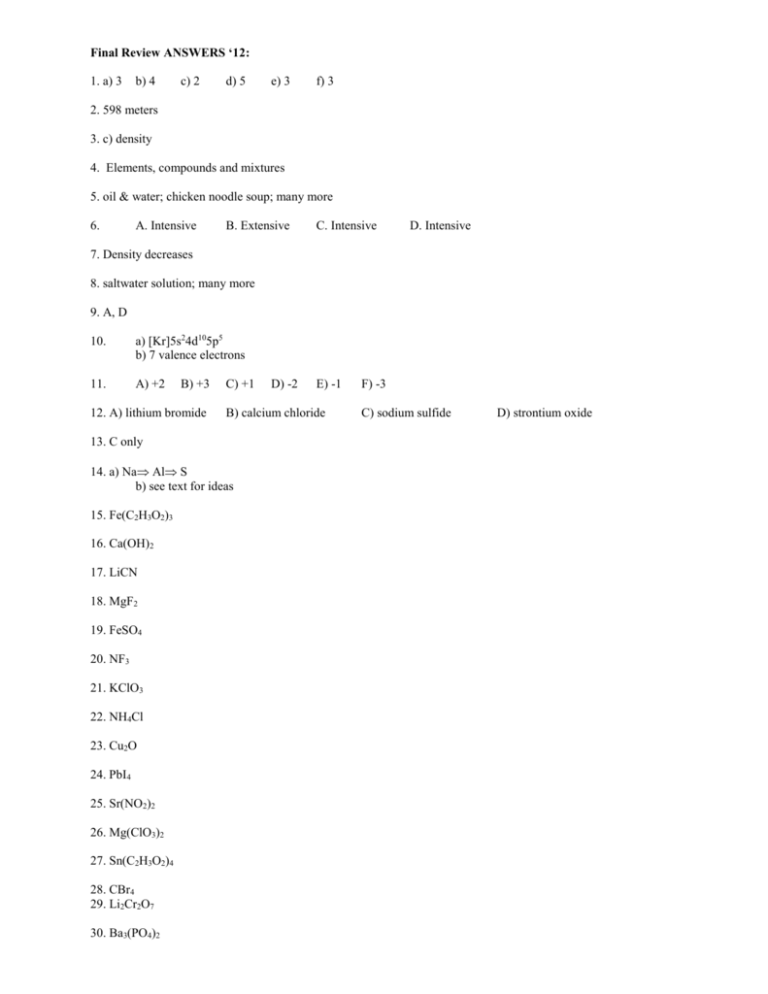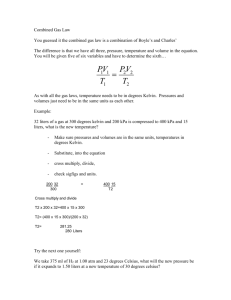ANSWERS to review questions
advertisement

Final Review ANSWERS ‘12: 1. a) 3 b) 4 c) 2 d) 5 e) 3 f) 3 2. 598 meters 3. c) density 4. Elements, compounds and mixtures 5. oil & water; chicken noodle soup; many more 6. A. Intensive B. Extensive C. Intensive D. Intensive 7. Density decreases 8. saltwater solution; many more 9. A, D 10. a) [Kr]5s24d105p5 b) 7 valence electrons 11. A) +2 B) +3 12. A) lithium bromide C) +1 14. a) Na Al S b) see text for ideas 16. Ca(OH)2 17. LiCN 18. MgF2 19. FeSO4 20. NF3 21. KClO3 22. NH4Cl 23. Cu2O 24. PbI4 25. Sr(NO2)2 26. Mg(ClO3)2 27. Sn(C2H3O2)4 28. CBr4 29. Li2Cr2O7 30. Ba3(PO4)2 E) -1 B) calcium chloride 13. C only 15. Fe(C2H3O2)3 D) -2 F) -3 C) sodium sulfide D) strontium oxide 31. aluminum chlorite 32. Tin (IV) bicarbonate 33. potassium iodide 34. cesium sulfide 35. aluminum chromate 36. potassium carbonate 37. phosphorus triiodide 38. rubidium sulfide 39. beryllium iodide 40. aluminum oxide 41. silver nitrate 42. calcium phosphide 43. copper (II) iodide 44. diphosphorus hexoxide 45. zinc chlorite 46. magnesium phosphide 47. a) 6.02 x 1023 particles b) 2 moles 48. a) 59 g b) 85 g c) 601 g d) 74 g 49. 18 g 50. 347.8 g 51. C 52. 4.28 x 1023 atoms Cd 53. 28.38 liters N2 54. 3 moles of Carbon 55. 27.8 grams 56. 7.09 x 1023 atoms 57. 14.0 liters of O2 58. a) 4Al + 3Pb(NO3)4 4Al(NO3)3 + 3Pb b) 7.02 x 1023 atoms of lead 59. a) 3Pb(NO3)2 (aq) + 2(NH4)3PO4 (aq) Pb3(PO4)2 (s) + 6NH4NO3 (aq) b) Double Replacement Rxn; c) 40.8 g 60. any example which describes a transfer of energy. 61. A) 1273 K B) 315 K C) 140 K 62. -273 C / 0 K 63. 38.8 grams 64. 0.485 J/g-C 65. Air pressure is caused by the collisions of gas molecules against the walls of their container. 66. 270 liters 67. 790 kpa 68. 95.9 kpa 69. 87.91 kpa or 0.8679 atm 70. 1.31 x 10-3 g/cm3 71. 159 liters 72. a) see bonding chapter b) B=linear; C=tetrahedral; D=linear; F=pyramidal 73. 1) a 2) b or g 3) f 4) e. 5) h (not a good question) 74. must be transparent (not cloudy) and the particles cannot ever settle out. 75. 353 grams of K2O 76. [NO2]2 x [O2] [NO3]2 77. [N2O4] = 0.033 M 78. a) shift left because increased temp. favors the endothermic direction. b) shift left because it speeds up reverse reaction c) shift right because increases forward reaction. 79. [HI] = 3.05 M 80. Less pressure will allow more gas to form. The equilibrium will shift in the direction that has more moles of gas 81. [NH3] = 0.0367 M 82. [Ag+] = 7.0 x 10-7 M 83. [H+] = 7.3 x 10-3 M 84. [H+] = 2.0 x 10-2 M 85. H3O+ 86. HNO3 : [H+] = 1.5 M ; HCN : [H+] = 3.0 x 10-5 M 87. Pairs: HF(acid) and F- (base) / SO32- (base) and HSO3- (acid) 88. [H+] = 6.7 x 10-14 M 89. pH= 1 (1.3 w/o sigfigs) ; HNO3 H+ + NO390. pH = 13 91. pH = 2.10 92. A) Ba(OH)2 + 2HCl BaCl2 + 2H2O B) 0.11M Ba(OH)2 93. 4.0 x 10-14 M 94. pH = 1.66 95. pH = 4.46 96. A) +6 B) +4 97. A) +6 B) +6 C) -2 D) +6 98. A) 4Al + 3O2 2Al2O3 B) Aluminum is oxidized; oxygen is reduced 99. Oxidation 1/2 reaction: 2Cs --> 2Cs+1 + 2eReduction 1/2 reaction: Cu2+ + 2e- --> Cu Reduction takes place at the cathode (REDCAT) Voltage: 3.26 V 100-102 see text and class notes 103. H = [Hf Prod] – [Hf react.] H = -9040 KJ 104. a) 1.08 x 104 Hz b) 7.1 x 10-30 J





